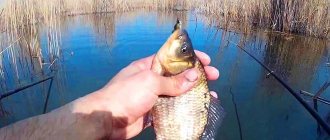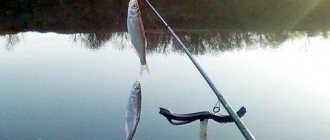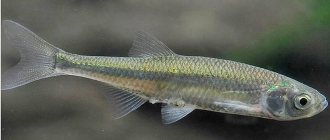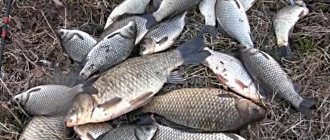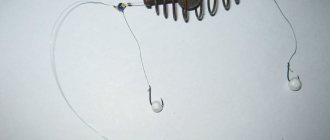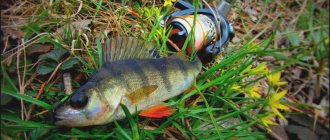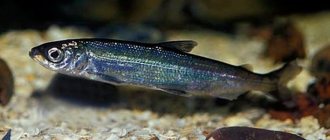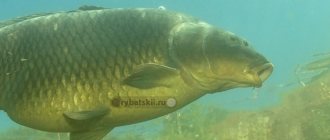Fish behavior in winter
In the summer, many have had the opportunity to observe large flocks of bleak looking for food in the surface layers of the reservoir. However, with the arrival of autumn, the fish tend to live a bottom lifestyle. The flocks spend most of the winter period at the bottom. However, the fish’s mouth is designed to pick up falling food. This feature must be taken into account by the fisherman when purposefully catching bleak from the ice. • In small, non-freezing rivers in winter, the food supply for fish becomes very poor. To survive, larger individuals eat smaller relatives. Fans of spinning rods know this when they go out in winter with summer tackle and small lures. • But on frozen reservoirs, schools of bleak occupy bottom horizons where there is a sandy or pebble surface. Attention! It is futile to look for fish in areas of the reservoir with a muddy bottom. This is due to insufficient oxygen content in the water near dead vegetation. The behavior of bleaks in winter is significantly influenced by the activity of the predator. And pike, pike perch, and perch are not averse to eating it. As soon as the predatory fish goes hunting, schools of silver fish begin to change feeding places, moving throughout the entire reservoir. During such a period, the fish is not picky, grabbing any available falling food. When the flock is not disturbed by anyone or anything, the winter bite of bleak becomes a test for the nervous system of an ice fishing enthusiast. The bites happen so quickly that the angler has to show lightning-fast reactions to hook in a timely manner.
Where and when to fish
When going for bleak in winter, you need to know in which areas of the reservoir the fish are concentrated. This largely depends on when the ice shell bound the reservoir. • In the first days after freeze-up, you should look for a school of active fish in bays and oxbows that are rich in aquatic vegetation. Here the fish finds insect larvae and other tiny food. • After the formation of a thick ice shell, the swarms move to deep holes, where they reduce their activity. • During periods of prolonged thaw, when melt water enters the reservoir, bleak is easily caught from the ice in the upper layers. She climbs up to search for food. When determining a promising fishing area, it is important to find out the structure of the bottom. The fish prefers a sandy or pebble bottom, avoiding areas with muddy sediments. For a number of reasons, it is necessary to catch bleak in winter on large lakes and reservoirs where there is good water exchange.
To find a school of active fish, you need to drill several dozen holes at different points in the reservoir. Sometimes active bleak can be detected while fishing for roach or perch. Useful observation! Some fishermen use a clever trick to locate bleak habitats. The flock feeds where fellow hobbyists often make sharp movements with their arms.
Fishing technique
Having arrived at the fishing spot, you need to drill two holes side by side and install two float winter fishing rods. Carefully remove all ice chips that have formed as a result of drilling holes. Otherwise, it will freeze and bring you a lot of unnecessary trouble.
Make sure that you have everything at hand, and this is a ladle, a container for caught fish and a hook, which may be needed when grabbing large fish. This sometimes happens, since pike, pike perch and large perch are constantly hunting for bleak.
It is usually enough to put one bloodworm or burdock larva on the hook. You determine the fishing depth on the spot, fishing all water horizons. When biting, do not make strong hooks, otherwise you can tear off the fish’s lip, since it is very delicate.
Once you have installed your fishing rods, do not leave them to the mercy of “fate.” That is, constantly conduct active fishing. To do this, constantly raise the fishing rod so that the bait seems to float away and the bleak after it will bite much more often if it remains motionless. The bait is thrown into the hole after 30 minutes of fishing, and sometimes this can be done more often. Everything will depend on the intensity of the bites.
Be sure to take a thermos with hot sweet tea with you. It will help you not freeze on the pond. A capacity of 2 liters is the optimal size of a thermos. It will last you the whole fishing day. Drink a glass of hot tea every 2-3 hours, and you will feel great while fishing throughout the day. Some take coffee with them, but believe me, it does not warm the body well.
Fishing rod equipment
To effectively catch fast and cunning bleak, the angler needs to assemble elegant and sensitive gear. 1. A lightweight fishing rod with a sensitive nod is equipped with the finest fishing line 0.06-0.08 mm. With active biting, it is allowed to thicken the monofilament to 0.07-0.09 mm. 2. A small jig with a contrasting body and a small hook No. 20-24 is tied to it. Attractive bait color combinations are: • black with orange dots; • brown with yellow splashes.
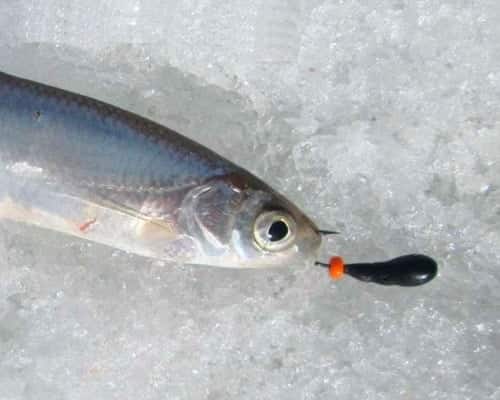
Athletes pay special attention to setting up the nod. He must react sensitively to the slightest touch of the fish. Each angler chooses the color of the nod for himself. As for the material, a strip of lavsan 40-50 mm long works best. Some experienced anglers prefer to use traditional wild boar bristles as a nod.
How to catch, bleak tackle
When fishing from the shore, they take long 5-7 meter rods. The best ones are bleak ones, as they are light and allow you to fish a large area of the reservoir. Specialized blanks allow you to fish comfortably, preventing your hand from getting tired after frequent casts.
If you fish from a boat, 2.5 - maximum 4 meters of blank length is enough. The equipment is the same as in summer and spring, we will not dwell on it. The site contains information, both in the “gear” section (see site menu), and separate articles on its elements.
The fishing technique is as follows:
- We throw a small ball of bait, cast it there, retrieve, if there is no attack, a slight twitch, retrieve again. We repeat several times.
- If there is no bite, we change the depth descent. Next in the same order: casting - wiring. At the first bites, we fish in the found horizon.
Feed constantly, volume - take a pinch, roll it into a ball, and after 1-2 casts it’s at the fishing point.
Lures
Fishing for bleak in winter can be done both with reelless jigs and baited models. The best jigs for fishing silver small fish are those with the shape of a ball, an oat grain or a droplet. The weight and size must correspond to the depth at the fishing point. Attention! The heavier the jig, the faster it will sink in the water column. The bleak doesn't always like this. Athletes consider jigs with a diameter of up to 2.5 mm to be the optimal bait. When using attached jigs, baits will play an important role. • Bloodworms are considered the best bait in winter for catching bleak. An alternative to this universal bait can be a burdock moth larva, Chernobyl or small maggot. • Among the attachments of plant origin, we should highlight bread, semolina, and various cereals.
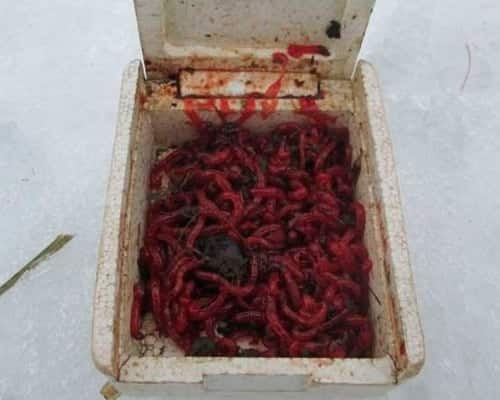
What to catch bleak with
Most often, this fish is caught using the classic bait – maggot. For fishing to be successful and bring a good catch, you need to take larvae of different sizes with you. The larger ones are suitable for active biting, but if the bleak suddenly starts to be picky, then you can switch to smaller ones. In cases where the bites are too cautious, it is better to fish with another catchable larva - bloodworms. Sometimes a miniature bread roll works well.
How to properly attach a maggot to a hook? If you hook it on the skin at one end, it will wriggle seductively. But this method has one significant drawback - the fish constantly manages to tear off the bait. Therefore, it is better to pierce the larva right through so that the sting comes out. With this option, there will be much fewer idle hooks, and the bait on the hook will last longer.
Bloodworms are usually skewered in the same way as in winter fishing on a jig. That is, they pierce it right through in the thick part. The “half-ring” and “ring” mounting methods are of little use for gluing. Unlike bream or roach, this fish is more influenced by the natural behavior of the bait, and not by its smell. Of course, it is easier to tear off a bloodworm hooked to the tip, but if the angler does not rush and waits 3 seconds after the bite, the fish will definitely swallow the larva completely and the hook will be crowned with success.
If up to 10 individuals can be caught per maggot, then balls of dough or bread crumbs have to be rolled after each hooking, regardless of whether it is effective or not.
Feeding
Without bait, you can’t even count on a decent catch of bleak. The components of the mixture gather fish at one point, create competition and thereby force the fish to more actively grab food. Including the one on the hook.
The only requirement for bait for catching bleak is that it should sink as slowly as possible. Wheat breadcrumbs have this property. Also, powdered milk, ground cake and a small amount of cocoa powder will not hurt. Good bait is made from store-bought cookies ground using a coffee grinder. You can also use any commercial bait for white fish, if you first grind it to a powder state.
The dry mixture is diluted to the required consistency with water taken from the reservoir. After casting, the lump of bait immediately disintegrates and forms a stable cloudy spot. The longer it “hangs” in the water column, the more bleaks will be collected.
The first three handfuls are thrown behind the intended fishing point in a row: a meter or one and a half from it, the second a little closer, and the third almost to where the float will be located. This “path” will attract fish from a long distance, where bait cannot be thrown. Then two or three more lumps should be thrown directly into the fishing spot. The nearest flock will instantly react to the splashes and gather at the point.
The fall of bait, like any other small objects, does not frighten the bleak at all, but, on the contrary, attracts its attention. Therefore, during the fishing process, you should periodically throw in small lumps
Experienced fishermen literally catch this nimble fish with both hands: they feed with one, and hook with the other.
The main rule of feeding is accuracy. You cannot scatter the bait mixture over the area, otherwise the fish will scatter. The balls must fall in the same place. The rate of feeding is established experimentally, and then strictly observed. For example, a small lump after two fish caught. Since most of the bait will sink to the bottom, you can try to increase the fishing depth. It is quite possible that larger specimens will be pecking at the bottom.
The size of the bleak is more than modest, and yet it is worthy of respect. Every fisherman comes to this conclusion, especially in those moments when all the other inhabitants of the reservoirs seem to have disappeared into the ground. Most often this happens in the first half of summer, when the first “hot wave” hits. The fish becomes lethargic and passive, so you have to enjoy the sport of bleak fishing. Without it, many would sit at home and look forward to the first cold weather.
Features of feeding
You can’t do winter fishing without bait. It is important not only to choose the right composition, but also to carry out feeding correctly. • Having discovered points where small things accumulate, the angler should feed promising holes. Since this fish has an excellent appetite, it is necessary to periodically add food, which creates a column of turbidity. • Breadcrumbs are used as the basis for bait. Protein ingredients are added to them, as well as a little of the bait that will be used for fishing. Experts do not recommend adding flavorings to the mixture. • The density of the bait ball depends on the depth and the presence or absence of current. The bleak will remain under the hole until the smallest particles of food sink to the bottom. • If a lot of food ends up on the bottom, this can have both a positive and negative effect. Large bleak often bite in the bottom layer. But a perch or bream may approach the resulting spot, which will scare away the school. • When there is a current in a reservoir, it is noticed that the bleak becomes lower than other types of fish. Twin holes help to cope with this situation. The distance between the holes is 0.5-1.5 m. The bait is lowered into the hole, which is located upstream, and fishing is carried out in the hole below.
Winter bleak
Nowadays there is a widespread belief that bleak is not caught in winter. It is believed that only at the very last ice, when dense schools of hungry fish after wintering enter deep-sea bays and river mouths, does the very short-term extraction of these fish from under the ice begin. Experience shows that this is not so. Several years ago, I accidentally discovered the fact that bleak can be caught almost all winter.
Place and time of fishing
In January I fished on one of the low-flow lakes. I fed it by pouring breadcrumbs directly into the hole. We caught roach and small bream from a depth of 6-7 m. But closer to lunch, cautious bites began to be observed when lowering the jig. The bites occurred at a depth of one and a half to two meters below the ice. Then I took a fishing rod with a small jig, poured crackers into the next hole, baited the bloodworm, set the line release a couple of tens of centimeters below the ice level and lowered the bait into the hole. A barely noticeable bite was not long in coming, a hook, and an empty jig in the hand, this happened several times. I had to redo the gear. So I designed a purely sporting tackle on a fishing line with a diameter of 0.06 mm, hooked another bloodworm, and after a few seconds I pulled the troublemaker onto the ice. It turned out to be a fairly decent-sized bleak. At first it seemed to me that it was dace, but no, it was just bleak. And, as they say, off we go. As soon as the tiny jig dropped below the ice level, a neat but clear bite followed, and the next bleak ended up on the ice. And this continued until the surface of the hole was covered with a continuous layer of crackers; as soon as the hole began to clear, the bites moved to greater depths and then quickly stopped, that is, the bleak clearly moved away from the light. But as soon as more crackers were poured in, the bites quickly resumed.
I was interested to check whether bleak would be caught throughout the entire reservoir or only in a randomly discovered place. To do this, about four dozen holes were drilled at intervals of 15 m both along and across the reservoir, I poured crackers into them and began checking them for the presence of bleak. It turned out that the bleak is concentrated in a certain area directly above the bed of this elongated lake. The highest concentration was observed above the channel itself, and the amount of bleak decreased noticeably as it approached the lower channel edge. Knowing the locations of individual holes outside the channel, I moved to the deepest (about 7 m deep) and spent the rest of the day catching bleak. Towards evening, small roaches began to appear, but it is believed that even ide does not feed in the middle of winter. But the most interesting thing is that then my friends and I repeatedly caught bleak after heavy snowfalls in mid-January at an air temperature of about minus 7 degrees. After this incident, we deliberately caught large quantities of bleak from the ice several times in January and February, and not only in that lake, but also in other lakes.
What conclusions did I come to? Firstly, if you hunt for bleak in winter, then you need to do it purposefully and purposefully. This means that you cannot be distracted by catching other fish. Secondly, it is very important to choose the right place for fishing to achieve success. The most promising places are above a flat, “trough”-shaped bed of a flowing lake, or above holes that are connected to the bed by bottom ditches or furrows. Obviously, bleak in such places feels most protected from pike or pike perch. It is characteristic that, once having found a suitable place, one could return to it throughout the winter. And only with spring warming and the appearance of melt waters, bleak gathers in dense schools and moves to the upper reaches of the lake, at which time it is well caught and stranded mixed with roach. However, spring fishing is short-lived due to the fact that the school moves quickly. Thirdly, when fishing, you should use gear designed specifically for catching this fish.
Tackle
I use two fishing tackles. The most effective of them is the jig. The fishing rod is a small reel with a diameter of 45-60 mm, embedded in a foam body. Such a body is not afraid of impacts on ice, is easily cleaned of frozen ice and snow, and is as light as possible. A fairly soft pole made of vinyl plastic or juniper is inserted into the body. Poles made of polycarbonate or fiberglass are usually more rigid, and this is bad, because the fish bite is lively, the line is very short and thin, and it is easy to tear off the jig or the lip of the fish when hooking. The optimal length of the pole is 200 mm. With shorter ones it is inconvenient to make a falling jig, and with a longer one it is more difficult to protect the guard from the wind.
A guard is attached to the end of the pole. I believe that a guard made from boar bristles is optimal. The bristles should be selected to be round in cross-section and as long as possible, so that it is possible to select the area of the required rigidity. Guards in the form of a flat spring or a piece of nipple are not suitable, because they are insensitive, and guards made of a twisted spring and made of Mylar film have unnecessary self-oscillations. The bristles are threaded through a hole in a piece of thick insulation for the electrical wire, and the fishing line is threaded through a Teflon casing, which in turn is also threaded through a piece of insulation. Such a gatehouse is not afraid of frost, is little affected by wind and is very sensitive. Sensitivity is perhaps the most valuable quality when fishing for bleak, the bites of which from under the ice can be very careful.
The body shape of the jig plays a role, since the body size of the jig is minimal. So, I often use jigs measuring 1.5 mm with a hook No. 20-24 with a long shank. I think that it is preferable to use a jig with a body that is maximally elongated in such a way that the body itself is like a continuation of the hook with a gradual thickening.
However, not every angler can make such a jig from a tungsten alloy, and lead ones are too light. But there is no need to be upset. There is another design of equipment that is not much inferior, and sometimes even superior to the first in efficiency. At the end of the fishing line, instead of a jig, a “bleak” hook is tied, and at a distance of 10-15 cm, a small lead pellet is attached to the fishing line. It is important to adjust the trigger so that the pellet falls below the ice only a few centimeters. The rig quickly drops to the bottom edge of the ice, and then the baited hook slowly falls. The fall is so natural that the bleak sometimes even swallows the bait.
If you are lucky and a thaw has set in, you can have fun fishing with a rig with a float. And not with a winter float, but with a summer, ordinary bleak float. To do this, take a ready-made summer rig with a float with a load capacity of 0.15-0.20 g and lower it into the hole; you just need to remember to lightly tug the rig so that the nozzle is in motion. I advise you to specifically try this kind of fishing. You can examine in detail the behavior of the equipment when biting. The only bad thing is that a layer of floating crackers gets in the way, and in a clean hole bleak is caught extremely poorly. However, you can do the following. Next to the hole, let's call it the first, a second hole is being drilled literally right next to it. This hole is filled with snow, a hole is made in the snow with a stick in the center, into which the tackle is lowered. Thus, the bait comes through the first hole, and fishing occurs through the “darkened” second.
Lure
Bait for catching bleak from under the ice is required. The simplest bait is regular breadcrumbs. It is preferable to make your own crackers rather than store-bought ones. Dried white bread and minced through a meat grinder will have many large and light fractions. And coarse crackers soak in water longer and sink more slowly. You can also use large bran, but always mixed with breadcrumbs. Bleak does not eat bran, and the effect of falling bait, if there are no edible particles in it, will be unstable and short-lived. A mixture of crackers and bran in a one to one ratio seems to me to be the most effective and cheapest. It’s a good idea to add either milk powder, or egg powder and a tablespoon of cocoa powder to the bait. I don’t think there’s any need to add any other components. If bloodworms are used as a bait, then it is good to add a handful of food bloodworms to the bait, or even better, take some large bloodworms, crush it and rub the remains into breadcrumbs. Pressed bloodworms not only attract bleak much faster and more efficiently, but also hold it in place well.
Nozzle
As a bait, as I already mentioned, you can successfully use bloodworms. A feeding bloodworm should be baited in a half-ring, and a large one in a ring, otherwise the bleak will tear the bait off with impunity over and over again. But the best winter bait is the burdock moth larva. Even better is Chernobyl, which is softer and smaller than burdock, and bleak cannot refuse such bait. During periods of good biting, the best bait should be considered a small maggot. During such periods, you can catch bleak without bait, you just need to not sit too long in one hole, but constantly follow the school of bleak. And do not forget that bleak always tends to stick to places above great depths. Probably, this behavior of the bleak is associated with the desire to protect itself from attacks by bottom predators. By the way, it has been noticed that during the movement of a school of bleak, pike perch and pike perch often begin to be caught in mid-water.
In conclusion, I would like to emphasize that catching bleak, despite its apparent simplicity and accessibility, is an interesting and creative activity. You can catch this fish with success almost all year round, with the exception of the freeze-up period and a few days after the ice melts on the reservoir, but as soon as the water in some tiny bay begins to brighten, the first one to touch the bait on the hook will be either a bleak or a roach .
Andrey Yanshevsky March 21, 2001 at 00:00
Fishing technique and tactics
In winter, as in summer, bleak bites occur abruptly and unexpectedly. Often the angler competes with the fish in reaction. The wiring is done slowly from bottom to top and back. Holding the bait at the bottom is not very promising. When the nod shakes slightly, the angler should prepare to hook. If there is a sharp twitch, there is no need to think twice; you should immediately strike. As fast as the hook is, it should not be powerful. Otherwise, the delicate lips of the fish will not be able to withstand it, and an offensive gathering will occur. More attention is required to tactical techniques when catching bleak. First, it is important to find a flock, then keep it under the hole, and only after that begin active fishing. It is necessary to act depending on the number of fish in a particular reservoir. • When there are a lot of fish in the fishing area and they are active, the starting feeding of small bloodworms is done in 4-6 holes. The fisherman walks around these holes 2-3 times, checking for the presence of fish. If the bleach does not manifest itself in the area under study, then another group of holes is prepared in a similar way in another place. As soon as the flock is discovered, it is necessary to lift it to the top layer, constantly lowering a pinch of bait. After this, active fishing begins. • If the bleak is passive or there is little of it in the reservoir, then the angler will have to focus on fishing a large number of holes. Having discovered a flock, they feed it with small portions of bait. Having concentrated the fish under the hole, fishing begins using delicate tackle. Even athletes do not neglect the extraction of bleak during competitions. After all, with the right approach, you can increase the weight of the caught fish in a short time. At the same time, you will be able to test your gear, as well as hone your high-speed fishing technique.
Habitats and catches
Bleak
- one of the most common, widespread and universally known fish. Inhabits the reservoirs of Europe from France to the east and north to the Northern basins. Dvina, Ural and Emba. Absent in Scotland and northern Sweden, and in Italy (south of the Alps and the Danube basin) and the Caucasus it gives way to other species and subspecies of bleak. In Russia, bleak is common in all rivers, lakes, ponds and floodplain reservoirs with clean water and a sandy bottom and is numerous everywhere.
Bleak distribution map
From early spring to late autumn, in open areas of reservoirs in clear sunny weather, large flocks of bleak can be observed at the very surface of the water. It is no coincidence that gulls, terns, loons and other water birds eat it more than other fish. All day, until dusk, the bleak is very active and is in constant movement, and only at night it rests almost motionlessly somewhere near the thickets or under overhanging coastal bushes and in places with a weak current. Bleak reacts very quickly to the appearance of other fish, especially predatory ones, trying to avoid meeting them, and yet this does not always save it from pike, perch, and especially from asp, for which these fish are a favorite food. For the winter, flocks of bleaks go to the depths, where they spend the entire cold season in wintering pits in a sedentary state.
When choosing a place to catch bleak
, first of all you need to focus on depth. Bleak loves deep places. Large bleak, rarely visits the coastal zone with a depth of less than 2 meters. The wind will also help you find the bleak.
The mounted fish tends to the leeward shore, in the calm formed by steep banks and trees, where wind-blown insects fall into the water. A school of bleak is not difficult to notice from the shore, since the fish feeding in the upper waters forms numerous stains on the water with its movements. In rivers, bleak avoids fast currents and prefers to stay in calm water and bays.
The bleak is easy to spot if you slowly approach the river bank or quietly swim across the lake. On the surface of the water it is enough to throw a handful of bait, a crust of bread, or a piece of polystyrene foam. A flock of perch immediately rushes to the fallen object, beginning to circle it along the water surface. With the onset of the cold season, the fish go to the depths, and in winter they again occupy their favorite upper horizons.
